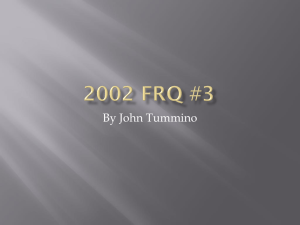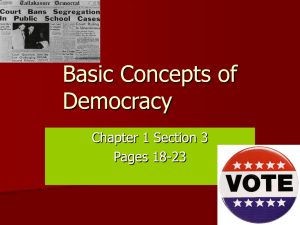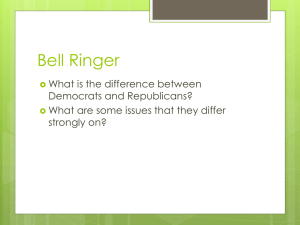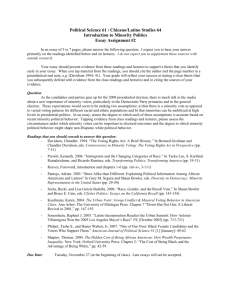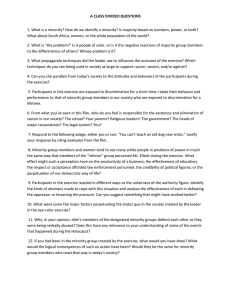MINORITY REPRESENTATION
advertisement
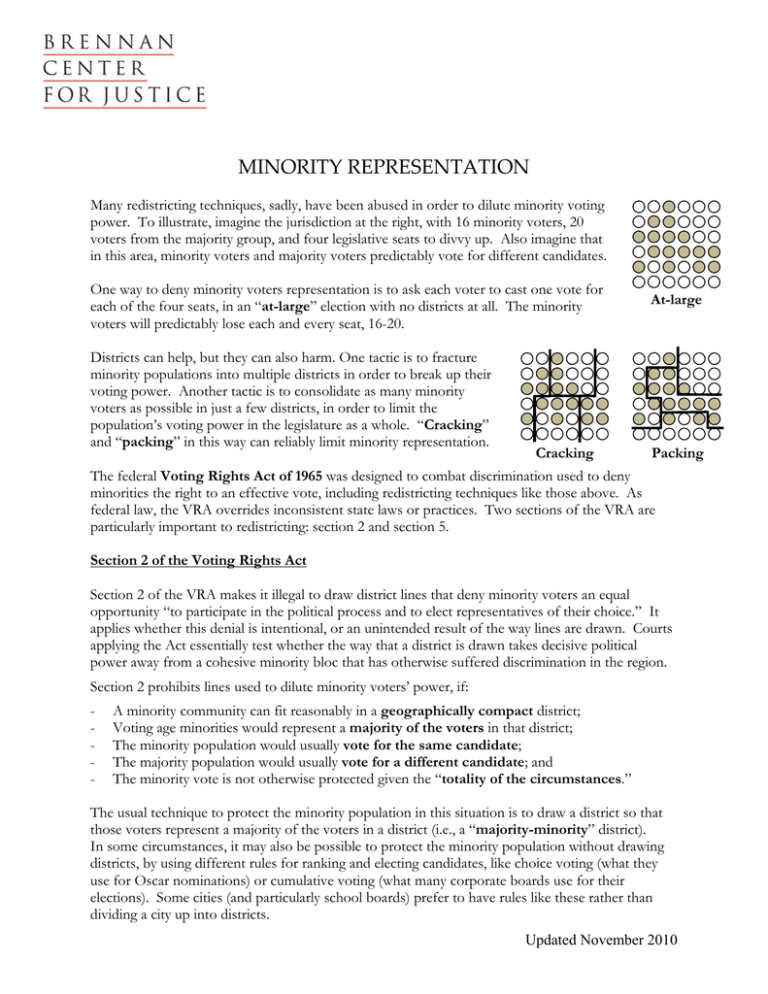
MINORITY REPRESENTATION Many redistricting techniques, sadly, have been abused in order to dilute minority voting power. To illustrate, imagine the jurisdiction at the right, with 16 minority voters, 20 voters from the majority group, and four legislative seats to divvy up. Also imagine that in this area, minority voters and majority voters predictably vote for different candidates. One way to deny minority voters representation is to ask each voter to cast one vote for each of the four seats, in an “at-large” election with no districts at all. The minority voters will predictably lose each and every seat, 16-20. Districts can help, but they can also harm. One tactic is to fracture minority populations into multiple districts in order to break up their voting power. Another tactic is to consolidate as many minority voters as possible in just a few districts, in order to limit the population’s voting power in the legislature as a whole. “Cracking” and “packing” in this way can reliably limit minority representation. Cracking At-large Packing The federal Voting Rights Act of 1965 was designed to combat discrimination used to deny minorities the right to an effective vote, including redistricting techniques like those above. As federal law, the VRA overrides inconsistent state laws or practices. Two sections of the VRA are particularly important to redistricting: section 2 and section 5. Section 2 of the Voting Rights Act Section 2 of the VRA makes it illegal to draw district lines that deny minority voters an equal opportunity “to participate in the political process and to elect representatives of their choice.” It applies whether this denial is intentional, or an unintended result of the way lines are drawn. Courts applying the Act essentially test whether the way that a district is drawn takes decisive political power away from a cohesive minority bloc that has otherwise suffered discrimination in the region. Section 2 prohibits lines used to dilute minority voters’ power, if: ­ ­ ­ ­ ­ A minority community can fit reasonably in a geographically compact district; Voting age minorities would represent a majority of the voters in that district; The minority population would usually vote for the same candidate; The majority population would usually vote for a different candidate; and The minority vote is not otherwise protected given the “totality of the circumstances.” The usual technique to protect the minority population in this situation is to draw a district so that those voters represent a majority of the voters in a district (i.e., a “majority-minority” district). In some circumstances, it may also be possible to protect the minority population without drawing districts, by using different rules for ranking and electing candidates, like choice voting (what they use for Oscar nominations) or cumulative voting (what many corporate boards use for their elections). Some cities (and particularly school boards) prefer to have rules like these rather than dividing a city up into districts. Updated November 2010 Section 5 of the Voting Rights Act Section 5 of the VRA works a bit differently. First, unlike section 2, it is temporary: it was last renewed in 2006, and is scheduled to come up for renewal again in the future. Section 5 Coverage Covered Partially covered Second, while section 2 applies all over the country, section 5 only applies in areas that had low levels of voter registration or participation historically — much of which was tied to disenfranchisement of minority voters. Nine states, and parts of seven others, are “covered jurisdictions” under section 5. (Coverage isn’t forever: in a procedure known as “bailout,” a covered jurisdiction can ask the federal trial court in Washington, D.C. to be released from Section 5, after ten years of steps to improve opportunities for minority voting.) In a covered jurisdiction, the government may not change district lines without getting the changes precleared by the Justice Department or federal court. New district lines will usually be precleared if: - The new map is not intended to dilute minority votes; and The new map leaves the current population of minority voters no worse off overall, in terms of political control, than the minority population would be if the old lines were kept in place. The Constitution and other considerations of race So the Voting Rights Act protects many populations of minority voters large enough to form a district’s majority, and also stops governments from backsliding to take away opportunities that minority voters had before. What about new groups of minority voters that aren’t quite big enough to be protected by the Voting Rights Act? The courts have spent a lot of time discussing the extent to which governments can take race into account in redistricting, as in other areas. Those who are drawing district lines can include race in their decisionmaking about where the lines should be placed. Under federal law, without a constitutionally compelling reason, race may not be the “predominant” reason for a district’s shape. But considering race as part of the overall mix, along with race-neutral redistricting factors like political preference and community interests and geographic considerations and the like, is proper. Courts generally assess the impact of race by looking at how irregular a district’s shape is, and then trying to figure out whether race, or other factors, best explain the irregularities. The more a district’s overall shape can be traced to other goals like those above, the less likely it is that voters’ race will be found to be the impermissibly driving force behind that district’s lines. Updated November 2010
